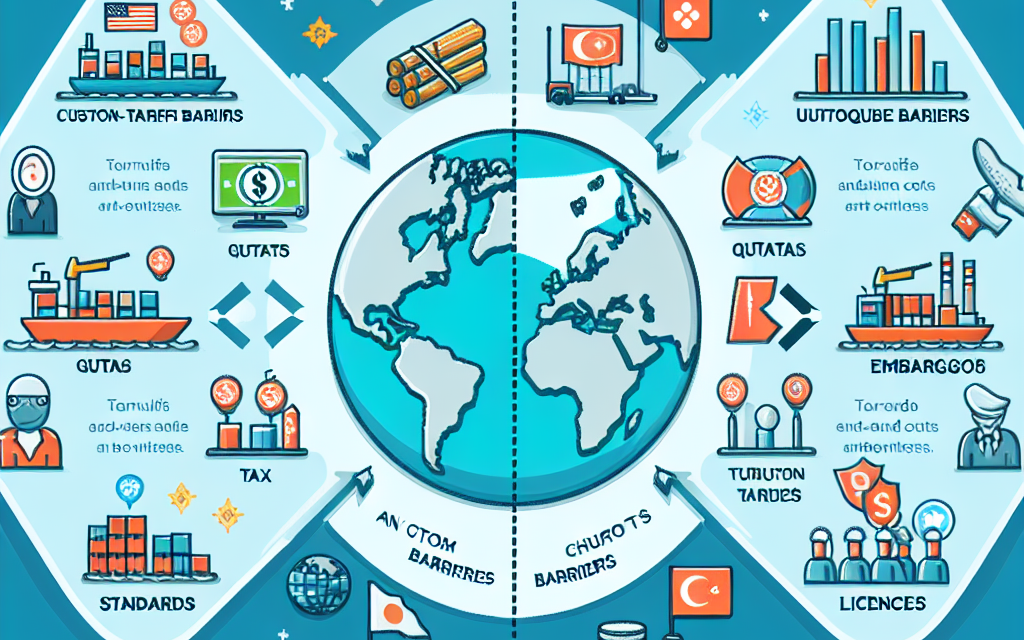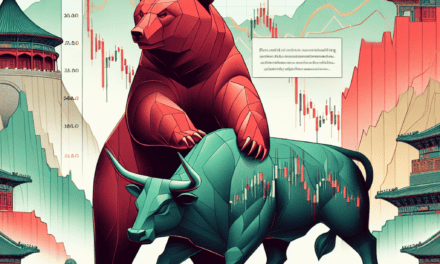“Unlocking Trade: Distinguishing Tariff and Non-Tariff Barriers for Smarter Decisions.”
Introduction
Understanding Tariff and Non-Tariff Barriers: Key Differences Explained
In the realm of international trade, barriers to entry play a crucial role in shaping the dynamics of global commerce. Tariff barriers, which involve taxes imposed on imported goods, directly affect pricing and competitiveness. In contrast, non-tariff barriers encompass a wide range of regulatory measures, such as quotas, import licenses, and standards, that can restrict trade without the use of tariffs. This introduction aims to clarify the key differences between these two types of trade barriers, highlighting their implications for businesses, economies, and trade policies. By examining the characteristics, purposes, and effects of tariff and non-tariff barriers, stakeholders can better navigate the complexities of international trade and make informed decisions.
Definition of Tariff Barriers
Tariff barriers are a fundamental aspect of international trade, serving as a crucial mechanism through which governments regulate the flow of goods across their borders. At their core, tariffs are taxes imposed on imported goods, which can significantly influence the pricing and competitiveness of foreign products in the domestic market. By increasing the cost of imports, tariffs aim to protect local industries from foreign competition, thereby fostering domestic production and employment. This protective measure can be particularly beneficial for emerging industries that may struggle to compete against established foreign players.
The implementation of tariff barriers can take various forms, including specific tariffs, which are fixed fees based on the quantity of goods imported, and ad valorem tariffs, which are calculated as a percentage of the value of the imported goods. These distinctions are important, as they can affect the overall cost structure of imported products differently. For instance, a specific tariff may disproportionately impact low-cost goods, while an ad valorem tariff could have a more uniform effect across various price points. Consequently, the choice of tariff type can reflect a government’s strategic priorities in protecting certain sectors of its economy.
Moreover, tariff barriers can also serve as a source of revenue for governments. By imposing taxes on imports, countries can generate significant income, which can be utilized for public services and infrastructure development. However, this revenue generation aspect can lead to a complex interplay between economic protectionism and fiscal policy, as governments must balance the need to protect domestic industries with the potential negative impacts on consumers and international relations. High tariffs can lead to increased prices for consumers, limiting their choices and potentially leading to inflationary pressures within the economy.
In addition to their protective and revenue-generating functions, tariff barriers can also have broader implications for international trade relations. Countries may engage in retaliatory measures, imposing their own tariffs in response to those levied by trading partners. This tit-for-tat dynamic can escalate into trade wars, which can disrupt global supply chains and negatively impact economic growth. As such, the strategic use of tariff barriers requires careful consideration of both domestic economic objectives and international diplomatic relations.
Furthermore, the World Trade Organization (WTO) plays a pivotal role in regulating tariff barriers on a global scale. Through various agreements, member countries commit to reducing tariffs and adhering to established rules governing trade practices. This framework aims to promote fair competition and reduce trade distortions, ultimately fostering a more open and equitable trading environment. However, despite these efforts, the use of tariff barriers remains a contentious issue, with ongoing debates about their effectiveness and implications for global trade.
In conclusion, tariff barriers are a multifaceted tool employed by governments to regulate international trade. While they serve to protect domestic industries and generate revenue, they also carry the potential for unintended consequences, such as increased consumer prices and strained international relations. As countries navigate the complexities of global trade, understanding the nuances of tariff barriers becomes essential for policymakers, businesses, and consumers alike. By recognizing the implications of these barriers, stakeholders can better engage in the global marketplace and contribute to a more balanced and sustainable economic landscape.
Definition of Non-Tariff Barriers
Non-tariff barriers (NTBs) are regulatory measures, other than tariffs, that countries use to control the amount of trade across their borders. Unlike tariffs, which are straightforward taxes imposed on imported goods, non-tariff barriers can take various forms and often involve complex regulations and standards. These barriers can significantly impact international trade by creating obstacles that may be less visible but equally effective in restricting imports. Understanding the nature of non-tariff barriers is crucial for businesses and policymakers alike, as they navigate the intricate landscape of global trade.
One of the most common forms of non-tariff barriers is the imposition of quotas, which limit the quantity of a specific product that can be imported into a country during a given timeframe. Quotas can create scarcity in the market, driving up prices and protecting domestic industries from foreign competition. In addition to quotas, countries may also employ import licensing requirements, which mandate that importers obtain permission before bringing certain goods into the country. This process can be cumbersome and time-consuming, often leading to delays that can hinder trade.
Another significant category of non-tariff barriers includes technical regulations and standards. These regulations can encompass a wide range of requirements, such as safety standards, environmental regulations, and labeling requirements. While these standards may be established with legitimate public health or safety concerns in mind, they can also serve as a means to protect domestic industries from foreign competition. For instance, if a country sets stringent safety standards that foreign manufacturers struggle to meet, it effectively limits the number of foreign products that can enter its market, thereby favoring local producers.
Moreover, non-tariff barriers can manifest through administrative procedures that complicate the importation process. Customs procedures, for example, can be a significant hurdle for international trade. Lengthy customs clearance processes, excessive documentation requirements, and arbitrary inspections can all serve to delay shipments and increase costs for importers. These administrative hurdles can disproportionately affect smaller businesses that may lack the resources to navigate complex regulatory environments.
In addition to these barriers, countries may also utilize subsidies and other forms of financial assistance to domestic industries, which can distort competition in international markets. By providing financial support to local producers, governments can enable them to sell their products at lower prices than their foreign counterparts, effectively undermining fair competition. This practice can lead to retaliatory measures from trading partners, further complicating international trade relations.
Furthermore, non-tariff barriers can also include measures related to sanitary and phytosanitary standards, which are designed to protect human, animal, and plant life from risks arising from the introduction of foreign goods. While these measures are essential for ensuring safety, they can also be manipulated to restrict imports under the guise of health concerns.
In conclusion, non-tariff barriers encompass a wide array of regulatory measures that can significantly influence international trade dynamics. By understanding the various forms these barriers can take, businesses and policymakers can better navigate the complexities of global trade. As the landscape of international commerce continues to evolve, recognizing and addressing non-tariff barriers will be essential for fostering fair competition and promoting economic growth on a global scale.
Key Differences Between Tariff and Non-Tariff Barriers
In the realm of international trade, understanding the distinctions between tariff and non-tariff barriers is crucial for comprehending how countries regulate the flow of goods and services across their borders. Tariff barriers, which are essentially taxes imposed on imported goods, serve to increase the cost of foreign products, thereby making domestic goods more competitive in the local market. These tariffs can take various forms, including ad valorem tariffs, which are calculated as a percentage of the value of the imported goods, and specific tariffs, which are fixed fees based on the quantity of goods imported. By imposing tariffs, governments aim to protect local industries from foreign competition, generate revenue, and sometimes even influence trade negotiations.
On the other hand, non-tariff barriers encompass a wide range of regulatory measures that countries employ to control the amount and type of goods entering their markets without resorting to tariffs. These barriers can include quotas, which limit the quantity of a specific product that can be imported, and import licenses, which require importers to obtain permission before bringing certain goods into the country. Additionally, non-tariff barriers may manifest as technical standards and regulations that products must meet to be sold in a particular market. Such standards can include safety regulations, environmental requirements, and labeling mandates, all of which can significantly impact the ability of foreign products to compete.
While both tariff and non-tariff barriers serve the purpose of protecting domestic industries, their mechanisms and implications differ markedly. Tariffs are straightforward and quantifiable, making it relatively easy for businesses and governments to assess their impact on trade flows. In contrast, non-tariff barriers can be more opaque and complex, often requiring a deeper understanding of regulatory environments and compliance processes. This complexity can create significant challenges for exporters, who must navigate a labyrinth of rules and standards that vary from one country to another.
Moreover, the economic implications of these barriers also diverge. Tariffs tend to have a more direct effect on prices, as they increase the cost of imported goods, which can lead to higher prices for consumers. In contrast, non-tariff barriers may not always result in immediate price increases but can create delays and additional costs associated with compliance, ultimately affecting the competitiveness of foreign products. Furthermore, while tariffs are often transparent and can be negotiated in trade agreements, non-tariff barriers may be less visible and more difficult to address in international negotiations.
In addition to their economic impacts, the political dimensions of tariff and non-tariff barriers also warrant consideration. Tariffs are often subject to public debate and scrutiny, as they can be seen as a direct form of protectionism. Conversely, non-tariff barriers may be less visible to the general public, allowing governments to implement protective measures without attracting as much attention. This can lead to a situation where non-tariff barriers are used more subtly to achieve protectionist goals while maintaining an appearance of compliance with international trade agreements.
In conclusion, while both tariff and non-tariff barriers play significant roles in shaping international trade, their key differences lie in their mechanisms, economic implications, and political visibility. Understanding these distinctions is essential for businesses and policymakers alike, as they navigate the complexities of global trade and seek to foster an environment that balances protectionism with the benefits of open markets.
Impact of Tariff Barriers on Trade
Tariff barriers play a significant role in shaping international trade dynamics, influencing both the flow of goods and the economic relationships between countries. At their core, tariffs are taxes imposed on imported goods, designed to increase their price relative to domestic products. This price elevation serves multiple purposes, including protecting local industries from foreign competition, generating revenue for governments, and sometimes even serving as a tool for political leverage. The impact of these barriers on trade can be profound, affecting not only the countries imposing them but also their trading partners and the global market as a whole.
One of the most immediate effects of tariff barriers is the alteration of trade patterns. When a country imposes tariffs on specific imports, it often leads to a decrease in the volume of those goods entering the market. As prices rise due to the added tax, consumers may seek alternatives, either by purchasing domestically produced goods or by turning to imports from countries that do not face such tariffs. This shift can benefit local industries, allowing them to grow and potentially create jobs. However, it can also lead to higher prices for consumers, who may find themselves paying more for goods that were previously affordable.
Moreover, the imposition of tariffs can lead to retaliatory measures from affected countries. When one nation raises tariffs, it often prompts its trading partners to respond in kind, resulting in a tit-for-tat escalation that can spiral into a trade war. Such conflicts can disrupt established trade relationships, leading to uncertainty in the market and negatively impacting businesses that rely on international supply chains. The repercussions of these trade wars can extend beyond the immediate parties involved, affecting global markets and economic stability.
In addition to altering trade flows, tariff barriers can also influence investment decisions. Companies often consider the tariff landscape when deciding where to locate production facilities or source materials. High tariffs may deter foreign investment, as businesses seek to avoid the additional costs associated with importing goods into a market. Conversely, countries with lower or no tariffs may become more attractive destinations for foreign direct investment, fostering economic growth and innovation. This shift in investment patterns can have long-term implications for the economic development of nations, particularly those that rely heavily on exports.
Furthermore, the impact of tariff barriers extends to the broader economic environment. By protecting certain industries, tariffs can lead to inefficiencies in the market. Domestic producers may lack the incentive to innovate or improve their products if they are shielded from foreign competition. This can result in stagnation within protected sectors, ultimately harming consumers who may face limited choices and higher prices. In contrast, industries that are exposed to international competition often experience greater innovation and efficiency, benefiting consumers through improved products and lower prices.
In conclusion, tariff barriers significantly impact trade by altering trade patterns, influencing investment decisions, and shaping the overall economic landscape. While they can provide short-term benefits to domestic industries, the long-term consequences often include higher prices for consumers, potential trade wars, and inefficiencies in the market. As countries navigate the complexities of international trade, understanding the implications of tariff barriers becomes essential for policymakers, businesses, and consumers alike. The delicate balance between protecting local industries and fostering a competitive market is crucial for sustainable economic growth in an increasingly interconnected world.
Impact of Non-Tariff Barriers on Trade
Non-tariff barriers (NTBs) have become increasingly significant in the landscape of international trade, often overshadowing traditional tariff barriers. While tariffs impose direct taxes on imported goods, NTBs encompass a wide range of regulatory and policy measures that countries employ to control the amount and type of goods entering their markets. These barriers can take various forms, including quotas, import licensing requirements, standards and regulations, and customs procedures. Understanding the impact of NTBs on trade is crucial for businesses, policymakers, and economists alike, as they can significantly influence market dynamics and international competitiveness.
One of the primary effects of non-tariff barriers is the increase in the cost of doing business for exporters. Unlike tariffs, which are straightforward and predictable, NTBs can be complex and vary widely from one country to another. For instance, stringent health and safety regulations may require exporters to invest in additional testing and certification processes to meet the importing country’s standards. This not only raises the cost of compliance but can also lead to delays in getting products to market, thereby affecting the overall competitiveness of exporters. Consequently, businesses may find themselves at a disadvantage, particularly small and medium-sized enterprises that may lack the resources to navigate these regulatory hurdles effectively.
Moreover, non-tariff barriers can lead to market fragmentation, as different countries implement varying standards and regulations. This fragmentation complicates the global supply chain, making it more challenging for companies to operate efficiently across borders. For example, a product that meets the regulatory requirements in one country may not be compliant in another, necessitating modifications that can be both time-consuming and costly. As a result, businesses may choose to limit their market reach, opting to focus on fewer countries where they can ensure compliance, which ultimately stifles trade and reduces consumer choice.
In addition to increasing costs and complicating supply chains, non-tariff barriers can also create an environment of uncertainty in international trade. The lack of transparency surrounding NTBs can lead to unpredictability for exporters, who may struggle to anticipate changes in regulations or standards. This uncertainty can deter investment and innovation, as businesses may be reluctant to commit resources to markets where the regulatory landscape is unclear or subject to sudden changes. Consequently, this can hinder economic growth and development, particularly in emerging markets that rely heavily on trade to bolster their economies.
Furthermore, non-tariff barriers can have broader implications for global trade relations. When countries impose NTBs, they may inadvertently provoke retaliatory measures from trading partners, leading to a cycle of protectionism that can escalate tensions and disrupt established trade agreements. This can undermine the principles of free trade and cooperation that many nations strive to uphold. As countries seek to protect their domestic industries, the resulting trade wars can have far-reaching consequences, affecting not only the countries involved but also the global economy as a whole.
In conclusion, the impact of non-tariff barriers on trade is multifaceted and profound. By increasing costs, complicating supply chains, creating uncertainty, and potentially straining international relations, NTBs pose significant challenges for exporters and policymakers alike. As the global economy continues to evolve, understanding and addressing these barriers will be essential for fostering a more open and equitable trading environment that benefits all stakeholders involved.
Examples of Tariff and Non-Tariff Barriers
Tariff and non-tariff barriers are essential concepts in international trade, each playing a significant role in shaping the dynamics of global commerce. To understand these barriers better, it is crucial to explore specific examples that illustrate their distinct characteristics and implications. Tariffs, which are taxes imposed on imported goods, serve as a direct financial barrier to trade. For instance, when a country imposes a 10% tariff on imported automobiles, it effectively raises the cost of these vehicles for consumers. This increase in price can lead to a decrease in demand for foreign cars, thereby protecting domestic manufacturers from foreign competition. Such tariffs can be particularly prevalent in industries deemed vital for national security or economic stability, such as agriculture and automotive sectors.
In contrast, non-tariff barriers encompass a broader range of restrictions that do not involve direct taxation. These can include quotas, which limit the quantity of a specific product that can be imported. For example, a country may set a quota on the importation of sugar, allowing only a certain amount to enter the market each year. This restriction can create scarcity, driving up prices and benefiting local producers who face less competition. Additionally, non-tariff barriers can manifest in the form of stringent regulatory standards. For instance, a country may require that all imported food products meet specific health and safety regulations, which can be challenging for foreign producers to comply with. Such regulations, while often justified on the grounds of consumer protection, can inadvertently serve as a barrier to trade by making it more difficult for foreign goods to enter the market.
Another example of non-tariff barriers is the use of subsidies by governments to support domestic industries. When a government provides financial assistance to local farmers, for instance, it can lower their production costs, allowing them to sell their products at lower prices than imported goods. This practice can distort competition and make it challenging for foreign producers to compete effectively. Furthermore, administrative procedures can also act as non-tariff barriers. Lengthy customs procedures, excessive documentation requirements, and complex import licensing processes can create obstacles for foreign businesses seeking to enter a market. These bureaucratic hurdles can delay shipments and increase costs, ultimately discouraging international trade.
Moreover, the concept of local content requirements is another significant non-tariff barrier. These requirements mandate that a certain percentage of a product must be produced domestically to qualify for sale in the local market. For example, a country may require that 60% of the components in a manufactured good be sourced from local suppliers. This policy can limit the ability of foreign companies to sell their products and can lead to increased production costs, as local suppliers may not offer the same efficiencies or pricing as international sources.
In summary, while tariffs and non-tariff barriers both serve to regulate international trade, they do so in fundamentally different ways. Tariffs impose direct financial costs on imports, while non-tariff barriers encompass a wide array of regulations and restrictions that can complicate or inhibit trade without necessarily involving taxation. Understanding these differences is crucial for businesses and policymakers alike, as they navigate the complexities of global trade and seek to balance the interests of domestic industries with the benefits of international commerce. By recognizing the various forms these barriers can take, stakeholders can better strategize their approaches to entering and competing in foreign markets.
Strategies to Overcome Tariff and Non-Tariff Barriers
In the complex landscape of international trade, businesses often encounter various obstacles that can impede their ability to operate effectively across borders. Among these obstacles, tariff and non-tariff barriers stand out as significant challenges. While tariffs are straightforward taxes imposed on imported goods, non-tariff barriers encompass a broader range of regulations and policies that can restrict trade. Understanding these barriers is crucial for businesses seeking to expand their global reach. However, recognizing the challenges is only the first step; developing effective strategies to overcome these barriers is essential for success in international markets.
To begin with, businesses can adopt a proactive approach by conducting thorough market research. This research should focus on understanding the specific tariff and non-tariff barriers that exist in target markets. By identifying the types of tariffs imposed on their products, companies can better assess the financial implications of entering a new market. Additionally, understanding non-tariff barriers, such as import quotas, licensing requirements, and standards regulations, allows businesses to tailor their strategies accordingly. This foundational knowledge enables companies to make informed decisions about pricing, product modifications, and market entry strategies.
Furthermore, engaging with local partners can significantly enhance a company’s ability to navigate these barriers. Local partners often possess valuable insights into the regulatory landscape and can provide guidance on compliance with local laws and standards. By collaborating with local distributors, agents, or joint venture partners, businesses can leverage their expertise to streamline the import process and mitigate the risks associated with non-tariff barriers. This collaboration not only facilitates smoother market entry but also fosters relationships that can be beneficial in the long term.
In addition to local partnerships, companies should consider investing in advocacy and lobbying efforts. Engaging with trade associations and industry groups can amplify a business’s voice in discussions about trade policies and regulations. By participating in these organizations, companies can stay informed about changes in trade agreements and regulations that may affect their operations. Moreover, collective advocacy efforts can lead to more favorable trade conditions, as businesses unite to address common challenges posed by tariffs and non-tariff barriers.
Another effective strategy involves adapting products to meet local standards and regulations. Non-tariff barriers often arise from differing safety, health, and environmental standards across countries. By investing in research and development to modify products for compliance with local regulations, businesses can enhance their competitiveness in foreign markets. This adaptability not only helps in overcoming non-tariff barriers but also demonstrates a commitment to quality and safety, which can resonate positively with consumers.
Moreover, companies can explore alternative markets that may offer fewer barriers to entry. Diversifying market presence can reduce reliance on a single market and mitigate the risks associated with tariffs and non-tariff barriers. By identifying emerging markets or regions with more favorable trade agreements, businesses can strategically position themselves to capitalize on new opportunities while minimizing the impact of existing barriers.
In conclusion, overcoming tariff and non-tariff barriers requires a multifaceted approach that combines thorough research, local partnerships, advocacy, product adaptation, and market diversification. By implementing these strategies, businesses can enhance their ability to navigate the complexities of international trade, ultimately leading to greater success in the global marketplace. As the landscape of international trade continues to evolve, staying informed and adaptable will be key to thriving in an increasingly interconnected world.
Q&A
1. **What is a tariff?**
A tariff is a tax imposed by a government on imported goods, making them more expensive and less competitive compared to domestic products.
2. **What are non-tariff barriers?**
Non-tariff barriers are regulatory or policy measures other than tariffs that countries use to control the amount of trade across their borders, such as quotas, import licenses, and standards.
3. **How do tariffs affect prices?**
Tariffs increase the cost of imported goods, leading to higher prices for consumers and potentially reduced demand for those products.
4. **Can non-tariff barriers restrict trade?**
Yes, non-tariff barriers can significantly restrict trade by creating obstacles that make it difficult or costly for foreign goods to enter a market.
5. **Are tariffs easier to quantify than non-tariff barriers?**
Yes, tariffs are straightforward to quantify as they are expressed as a percentage of the value of the goods, while non-tariff barriers can be more complex and less transparent.
6. **Do tariffs generate revenue for governments?**
Yes, tariffs generate revenue for governments as they collect taxes on imported goods, which can be used for public services and infrastructure.
7. **Can non-tariff barriers be discriminatory?**
Yes, non-tariff barriers can be discriminatory if they favor domestic products over foreign ones, potentially violating international trade agreements.
Conclusion
In conclusion, understanding the key differences between tariff and non-tariff barriers is essential for comprehending international trade dynamics. Tariff barriers involve direct taxes imposed on imported goods, affecting pricing and competitiveness, while non-tariff barriers encompass a range of regulations and standards, such as quotas, licensing requirements, and health and safety standards, which can restrict trade without direct financial costs. Both types of barriers can significantly influence trade flows, market access, and economic relationships between countries, making it crucial for policymakers and businesses to navigate these complexities effectively.





